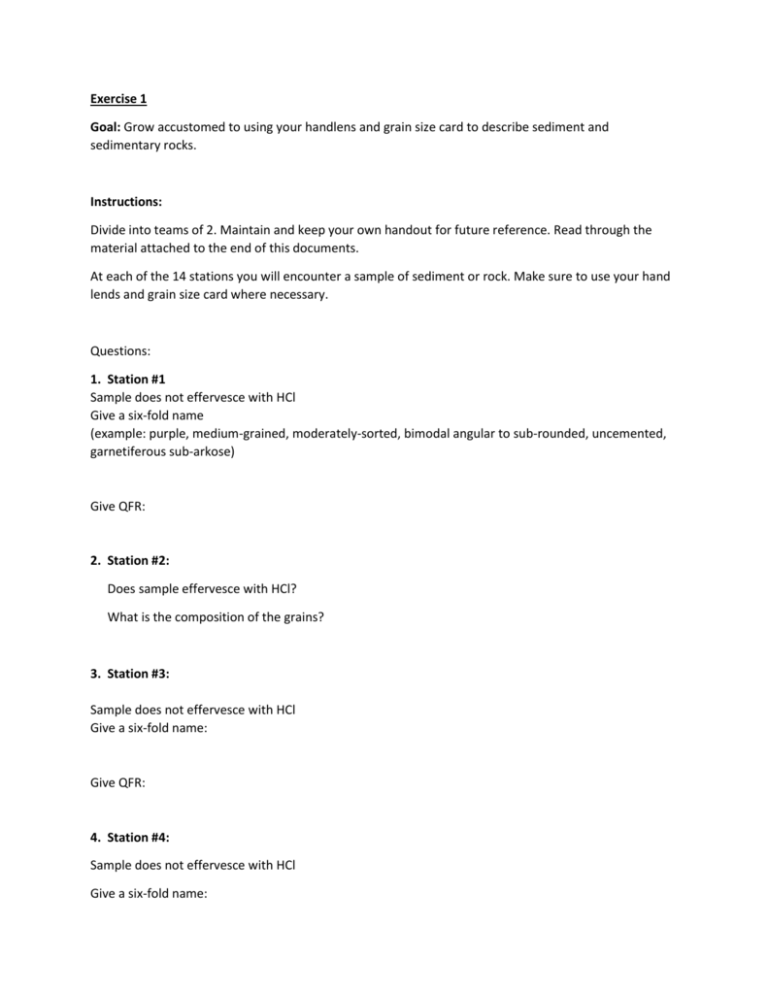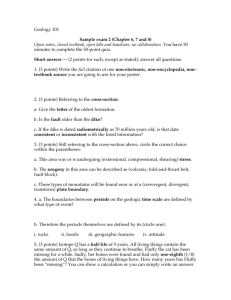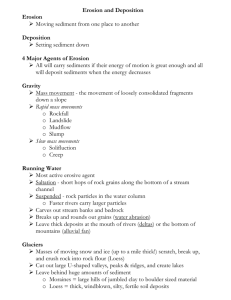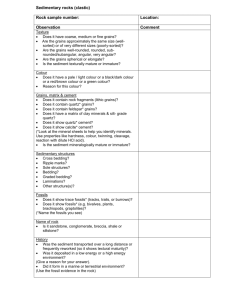Exercise 1 Goal: Grow accustomed to using your handlens and
advertisement

Exercise 1 Goal: Grow accustomed to using your handlens and grain size card to describe sediment and sedimentary rocks. Instructions: Divide into teams of 2. Maintain and keep your own handout for future reference. Read through the material attached to the end of this documents. At each of the 14 stations you will encounter a sample of sediment or rock. Make sure to use your hand lends and grain size card where necessary. Questions: 1. Station #1 Sample does not effervesce with HCl Give a six-fold name (example: purple, medium-grained, moderately-sorted, bimodal angular to sub-rounded, uncemented, garnetiferous sub-arkose) Give QFR: 2. Station #2: Does sample effervesce with HCl? What is the composition of the grains? 3. Station #3: Sample does not effervesce with HCl Give a six-fold name: Give QFR: 4. Station #4: Sample does not effervesce with HCl Give a six-fold name: Give QFR: Should you prefix your description with anything else? HINT: What are the purplish grains? 5. Station #5: What are these sediment grains? Without using HCl can you determine their composition? 6. Station #6: Sample does not effervesce with HCl Give a six-fold name: Give QFR: 7. Station #7: Sample does not effervesce with HCl Give a six-fold name: Give QFR: 8. Station #8: Sample does not effervesce with HCl Give a six-fold name: Give QFR: 9. Station #9: Sample does not effervesce with HCl Give a six-fold name: Give QFR: 10. Station #10: Sample does not effervesce with HCl Give a six-fold name: Give QFR: . 11. Station #11: Sample does not effervesce with HCl Give a six-fold name: Give QFR: 12. Station #12: Does the sample effervesce with HCl? Can you see sediment grains? Give a six-fold name: Give QFR: What is the clan name? (use the ternary diagram on the accompanying notes) 13. Station #13: Does the sample effervesce with HCl? Can you see sediment grains? Give a six-fold name: Give QFR: What is the clan name? 14. Station #14: Sample does not effervesce with HCl Can you see sediment grains? Name the rock. 15. There are two sediment samples that are composed of carbonate grains. Which ones are they? Some helpful reading Sandstones are composed of four architectural elements: Framework grains (detrital grains between 2 and 0.06 mm), detrital Matrix (silt and clay size), Cement (pore-filling authigenic minerals), and Pores. These are designated as FMCP components respectively. Matrix is the very small grains (<0.09mm) that fill in the space between the larger frame work grains and usually consist of clays, micas, quartz, and/or feldspars. Cement is the “glue” that binds together framework grains and most commonly is quartz, calcite, dolomite, or iron oxide. The three major framework constituents are sand-sized particles of quartz, feldspar, and rock fragments. Sandstones are assigned different names based on the most abundant framework grain present in the rock. To assign a sandstone to a clan, use the following procedure: 1). Estimate the percentages of quartz, feldspar, and rock fragments using Figure 1.A and Figure 1.C (both located at the end of the lab). The easiest technique is to estimate F and R and calculate Q mathematically. 2) Once percentage values have been determined the rock is described using a QFL chart (called a ternary diagram), like the one in Figure 1.B below. A sandstone that plots at any of the 3 corners (vertices) contains 100% of that component. For example a sandstone that plots on point F contains 100% feldspar. In moving from F to Q, the sandstone loses feldspar but gains quartz, with a sandstone of 100% quartz plotting at Q. 3) Thus, a sandstone can be characterized by the ratio FMCP:QFR. The value of FMCP must total 100% (of the total rock) and the QFR value totals 100% (of ONLY the framework grains). A complete description of a sample should include the following, but we will focus on only 6 parameters (color, grain size, sorting, roundness, main cement, clan): (1) Framework grains Q%F%R% (2) Clan name: based on the QFR estimates (3) Cement: composition and % (4) Matrix: % (5) Porosity: %. (6) Important other detrital grains (mica, opaques, glauconite, shells, etc.): % (7) Fossils: types and % Figure 1.B: Folk’s clan classification of sandstones. (8) Textures: grain size, sorting, rounding, imbrication, and textural maturity (9) Type of bedding (10) Color For this project you will describe sandstones using a 6-fold name = (color), (grain size), (sorting), (roundness), (main cement), (clan). The purpose of this lab is to enhance your ability to observe and describe textures, structures, and grain compositions in hand specimens. Quartz is the hardest mineral commonly found in sedimentary rocks and is therefore the most weather-resistant. It is generally milky white to grey or clear, and can be recognized by the presence of conchoidal fracture and the lack of cleavage planes. Feldspars (both K-feldspar and plagioclase) weather more rapidly and are pink or white (respectively) with cleavage planes. Rock fragments consist of igneous, metamorphic, or other sedimentary rock clasts and can be dark or pastel-colored. It is important to note that color alone is not always a reliable parameter for grain identification. Provenance clues that are useful include: 1. abundant elongate and polycrystalline quartz grains: suggestive of metamorphic terrains (elongate grains also may be from a pyroclastic source); 2. abundant chert: indicative of sedimentary terrain; 3. two or more populations of quartz as shown by size-roundness characteristics (e.g., angular coarse quartz plus rounded fine sand): indicative of reworked sediments; 4. grains with abraded overgrowths: reworked sediments; and 5. composition of feldspars, rock fragments, and heavy minerals that occur in the rock. Tectonically, quartzarenites tend to be formed under stable “quiescent” conditions, but exceptions are numerous. First-cycle quartzarenites can also form in humid, tropical regions of low relief. Those derived directly from granitic or metamorphic rocks require the longest period of stability. Textural maturity is largely a function of environment of deposition and is not a reliable clue to tectonic conditions. (Beach sands in a tectonically unstable area may be better sorted and probably better rounded than river sands in a tectonically quiescent area [Folk]). Quartzarenites may form in any environment, but dune, beach, and shallow-water marine environments are most common. The largest bodies of quartzarenites are sheet sands that accumulated during quiescent tectonic conditions. QUARTZARENITES A quartzarenite is here defined as a sandstone whose major framework grains are composed of less than 5% feldspar and less than 5% rock fragments; the remainder being quartz. Other constituents, such as clay, cement, fossils, micas, glauconite, and chemical minerals are ignored in determining the sandstone clan name, but are mentioned as miscellaneous constituents: micaceous quartzarenite, micaceous subarkose. Quartzarenites are mineralogically “supermature” sandstones, they contain only the most durable and insoluble terrigenous light and heavy framework minerals. Although they may have any textural maturity, mature and supermature textures are the most common. The most common cements are quartz, calcite, dolomite, and iron oxide; other cements are rare. Some rocks are poorly cemented and friable. Quartzarenites owe their mineralogical maturity to: 1) thorough chemical weathering of basement source rocks, 2) thorough loss by abrasion of constituents less durable than quartz (rare), 3) reworking of older sandstones, and 4) diagenetic loss of feldspar and rock fragments, or combinations of the above. Recycling should be suspected for all quartzarenites, especially those with mature-supermature textures, and for all rocks younger than Paleozoic age. The presence of significant oversize pores or oversize patches of cement suggest the loss of feldspar or rock fragments after deposition to form a “diagenetic quartzarenite”. Quartz is derived from three major source rocks: silicic plutonic rocks, silicic metamorphic rocks, and older sedimentary rocks. Quartzarenites may have a single parent rock (of the categories above), or mixed parents. Insofar as common quartz (monocrystalline non-undulose to slightly undulose) is the chief constituent of quartzarenites, and it is not diagnostic of source rocks, only other quartz types or other framework grains may be used to infer the source. LITHARENITES The litharenite clan includes sandstones in which fine-grained rock fragments exceed feldspar in abundance: litharenites and feldspathic litharenites contain >25% rock fragments; sublitharenite contains between 5 and 25% rock fragments. Litharenites in which a single rock-fragment type exceeds 25% of the framework should be given a special name (examples: shale-arenite, schist-arenite, volcanic-arenite, rhyolite-arenite, chert-arenite, etc.). Except for volcanic-arenites, which are commonly very coarse sandstones, most litharenites are fine to coarse sandstones. Very fine litharenites are rare, because when rock fragments undergo abrasion to very fine grain size they commonly disintegrate into their constituent minerals (quartz, feldspar, micas, etc). Owing to the relative ease of abrasion of common rock fragments, some litharenites can attain supermature textures. Submature to mature textures are most common, however. Litharenites with ductile rock fragments tend to lose considerable initial porosity through mashing of grains during compaction. Thus, they commonly have lots of pseudomatrix (mashed clay-bearing sand grains) and less cement than other sandstone clans. Quartz, calcite, clay, and iron-oxides are the most common cements. Volcanic-arenites commonly have chlorite, opal, chalcedony, or zeolite cement. Rock fragments provide superb clues to provenance. Rock fragments are identified on the combination of mineral composition, texture, shape, color, and, for soft grains, whether they have been deformed during compaction. ARKOSE CLAN The arkose clan includes sandstone classified as arkose, lithic arkose, and subarkose: sandstone containing feldspar in excess of rock fragments. Arkose contains more than 25% feldspar (of framework grains). The clan displays the complete spectrum of textural maturity, although immature to sub-mature textures are most common. Supermature texture is found in the thick eolian subarkose sandstones of the Mesozoic erg deposits of the western U.S. Common cements are quartz, kaolinite, hematite, calcite, mixed-layer clays, and feldspar (as overgrowths). Zeolite minerals and evaporite minerals (anhydrite, halite) are present locally. Sandstones of the arkose clan occur in all depositional environments, although non-marine rocks predominate. They have in common the fact that they are derived from feldspar-rich source rocks. Important "genetic" types of pure arkose include the following: 1) ""Tectonic" or “rift-basin” arkose - derived from uplifted granitic basement close to the basin of deposition; high topographic relief between source and basin. Commonly, this type occurs in thick clastic wedges with significant amounts of red beds. 2) "Basal arkose" - marine and non-marine sandstones which accumulated during transgression of the sea over a granitic or gneissic terrain. Such units are generally conglomerates at the base and grade upward into progressively finer and less feldspar-rich sandstones. 3) "Volcanic arkose" - derived from volcanic terrains (generally volcanic arcs) and therefore characterized by high-temperature feldspars (sanidine, anorthoclase, oscillatory-zone plagioclase), abundance of VRFs, and commonly abundant hexagonal biotite and euhedral apatite and zircon. Generally these are not red-beds; commonly transitional into volcanic arenites; generally marine. 4) "Climatic arkose" - derived from terrain of low relief but in cold or arid climates. Subarkose is more common than arkose; subarkose tends to be texturally mature. Feldspar is commonly rounded but uniformly fresh. Many subarkoses are bimodal (interdune) or well-sorted unimodal (dune) deposits. Types 3 and 4, sometimes 1, can (theoretically) be interpreted from thin-sections alone, but the field occurrence is commonly the best clue. Feldspar suffers during diagenesis in porous sandstones: K-feldspar alters to kaolinite and dissolves; plagioclase dissolves or alters to mixed-layer clays.







